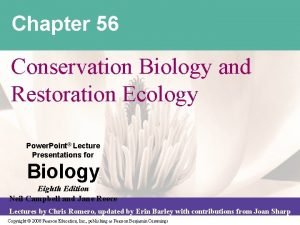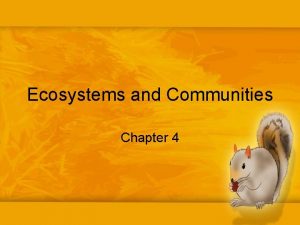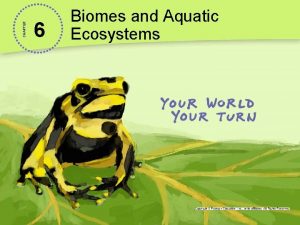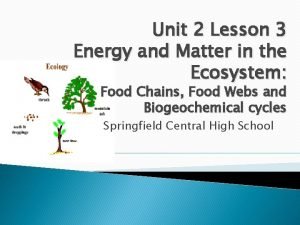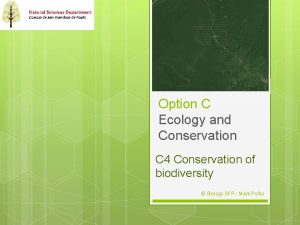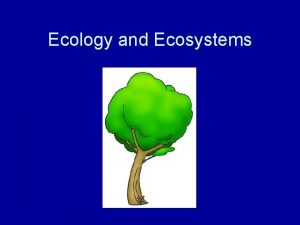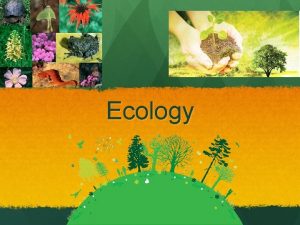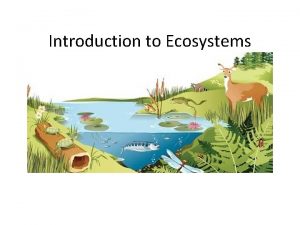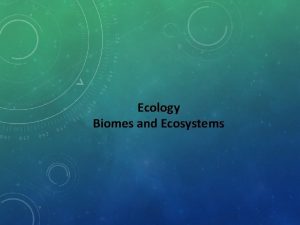Option G Ecology and Conservation G 2 Ecosystems












- Slides: 12

Option G: Ecology and Conservation G. 2 Ecosystems and Biomes

F. 2. 1 Define gross production, net production and biomass Units: k. J m-2 yr-1 Gross production = net production + respiration OR total amount of organic matter produced by plants in an ecosystem Net production = gross production - respiration Biomass = dry weight of an organism measured in g m-2 yr-1

F. 2. 2 Calculate values for gross production and net production using the equation: gross production – respiration = net production Example: Construct an pyramid of energy using the following information: Tropic level Producers Primary consumers Secondary consumers Tertiary consumers Energy flow (k. J m-2 yr-1) 20 810 3368 383 21

F. 2. 3 Discuss the difficulties of classifying organisms into trophic levels

F. 2. 4 Explain the small biomass and low numbers of organisms in higher trophic levels • Biomass is lost during respiration at each trophic level • Predators at the top of the pyramid must be large enough to catch prey; there can only be a few of them

F. 2. 5 Construct a pyramid of energy giving appropriate formation The total solar energy received by a grassland is 5 x 105 k. J m-2 y 1. The net production of the grassland is 6 x 102 k. J m-2 y-1. The total energy passed onto the primary consumers is 60 k. J m-2 y-1. Only 10% of this energy is passed onto its secondary consumers. • Calculate energy lost by plant respiration • Construct a pyramid of energy for this grassland.

F. 2. 5 Construct a pyramid of energy giving appropriate formation The total solar energy received by a grassland is 5 x 105 k. J m-2 y 1. The net production of the grassland is 6 x 102 k. J m-2 y-1. The total energy passed onto the primary consumers is 60 k. J m-2 y-1. Only 10% of this energy is passed onto its secondary consumers. • Construct a pyramid of energy for this grassland.

F. 2. 6 Distinguish between primary and secondary succession, using an example of each Ecological succession: change in species composition in a community over time. Primary Succession • Plants begin growing on previously lifeless area • Lacks organic soil • Example: • New volcanic island (lichen moss) Secondary succession • After primary succession • Upheaval of primary succession (plants) but has organic component (seeds/roots) • Example: • Recolonisation after forest fire

F. 2. 7 Outline the changes in species diversity and production during primary succession Example: Coastal sand dunes Foredune Yellow dune Grey dune Mature dune • thin soil layer • • Sedge and sand bindweed; • no soil dandelion and thistles • Pioneer plants: lyme and marram • Rabbits (droppings) • • Diversity increases grass • Limited diversity Humus develops (holds water) Thick shrubs • Thick humus • Supports forest • High diversity

F. 2. 8 Explain the effects of living organisms on the abiotic environment with reference to the changes occurring during primary succession • • Few species No soil New area Lichen and mosses are pioneer plants • Low biomass • Low production • • Many species Soil present Old area Seeds and roots already present • Higher biomass • Higher production

F. 2. 9 Explain how rainfall and temperature affect the distribution of biomes • Climograph plots temperature and rainfall in a particular region

F. 2. 10 Outline the characteristics of the major biomes
 Chapter 55 ecosystems and restoration ecology
Chapter 55 ecosystems and restoration ecology Chapter 55 ecosystems and restoration ecology
Chapter 55 ecosystems and restoration ecology Soal pilihan ganda (multiple choice)
Soal pilihan ganda (multiple choice) Option a option b
Option a option b Chapter 56 conservation biology and restoration ecology
Chapter 56 conservation biology and restoration ecology Chapter 4 ecosystems and communities vocabulary review
Chapter 4 ecosystems and communities vocabulary review Epiphytes plants
Epiphytes plants Why biomes are important
Why biomes are important Chapter 42 ecosystems and energy
Chapter 42 ecosystems and energy Chapter 3 lesson 3 biomes and aquatic ecosystems
Chapter 3 lesson 3 biomes and aquatic ecosystems Aquatic vs terrestrial
Aquatic vs terrestrial How does energy flow in an ecosystem
How does energy flow in an ecosystem Phosphorus cycle
Phosphorus cycle




